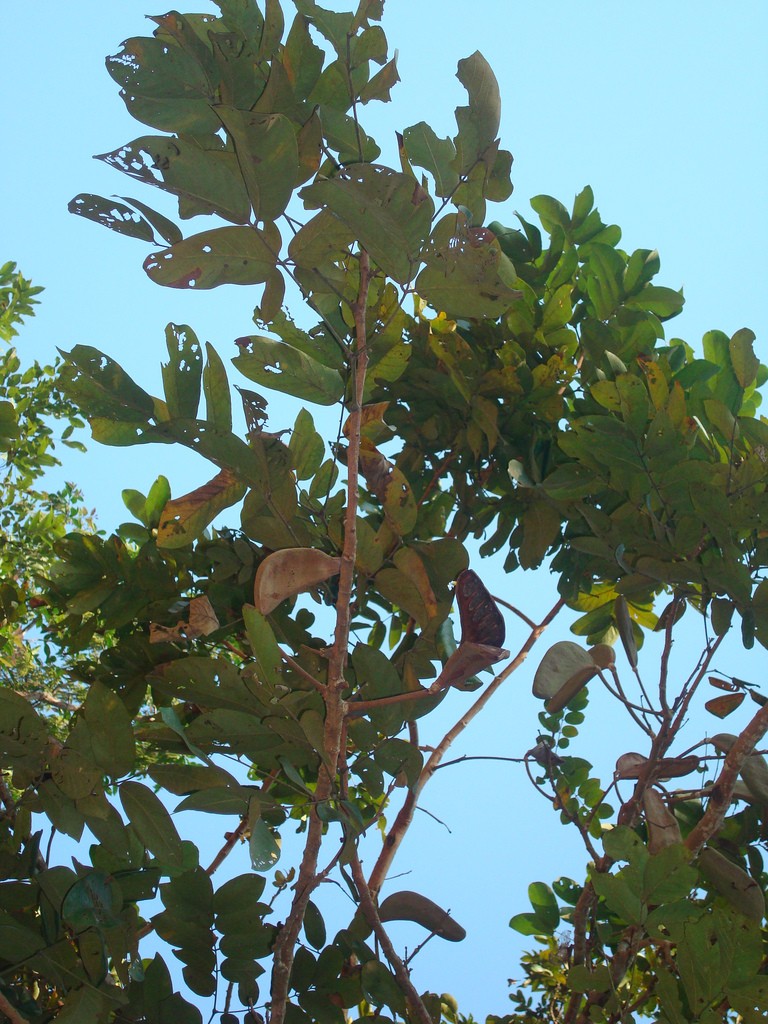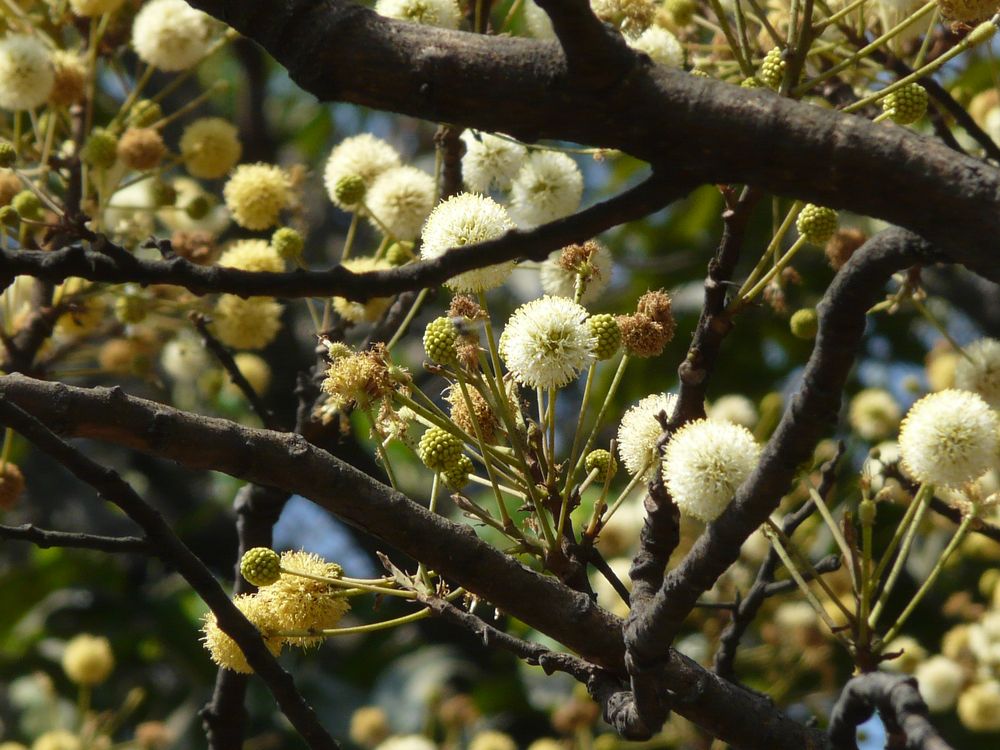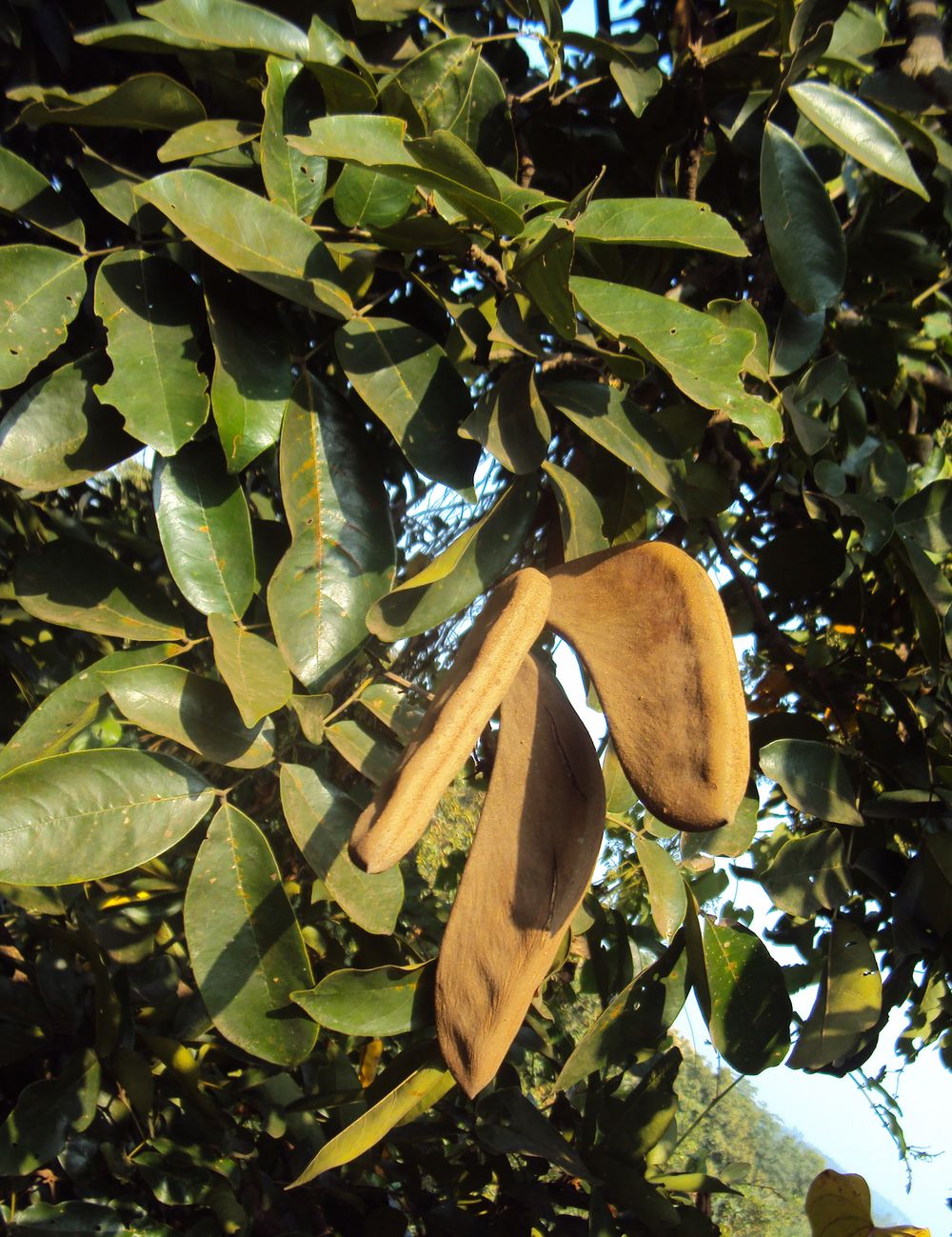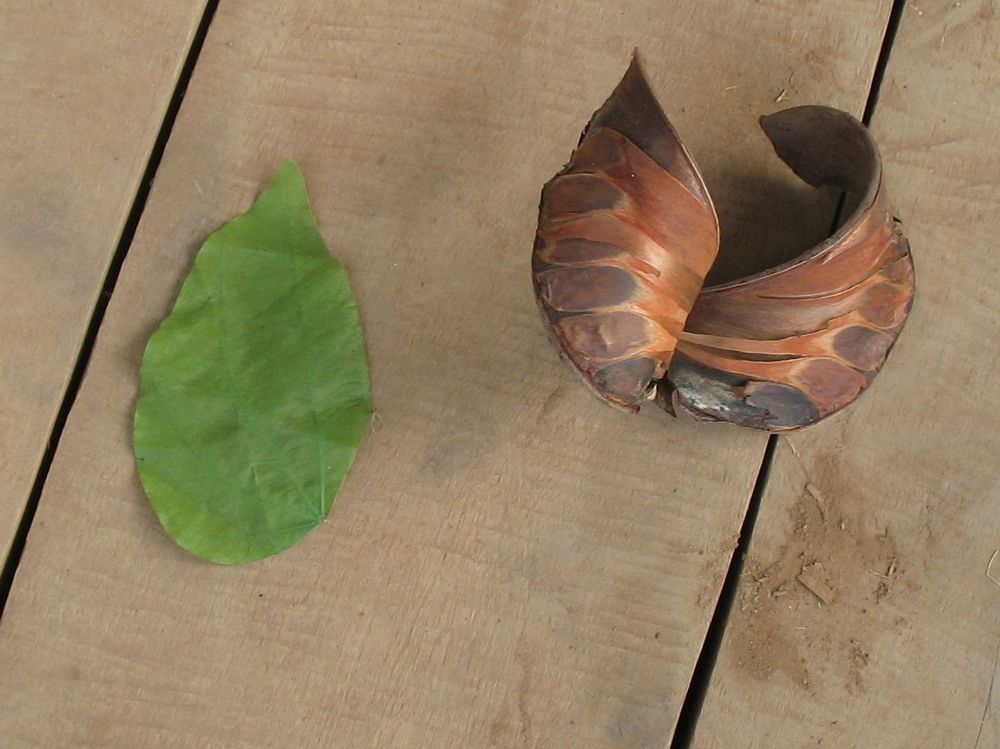To see the tone dèng (Xylia xylocarpa), one has to travel to the partially deciduous forests of southern Laos, where numerous leguminous plants and bamboos grow in both sandy and rocky soil.
This tall tree, 20-30 m. high has a greyish bark and its young branches are covered with a golden velvet. Its leaves are composed, bipennate, and alternate, with quite large, thick, oval sepals. The globular inflorescences, appearing at the axilla, are composed of 20-90 little white or yellowish flowers. The fruit is a reddish-brown, woody, flat, curved pod. Since it opens into two segments, a dozen brown seeds are in a neat row on each of the two perimeters.
The name of this tree refers to its wood. The scientific name repeats the Greek name, « xylos », which means wood, and xylocarpa, « ligneous fruit » (like wood). The western languages speak of « firewood » and in Lao, « red wood ».
In actuality, tone dèng is known for its very hard, redwood, which is, however, less sought out than, for example, that of tone sa beng (Dipterocarpus spp) or tone te kha (Afzelia xylocarpa). That does not prevent this ironwood from being considered endangered in both Laos and Thailand due to its having been over-cut. Clement, in his œuvre on ‘L’habitation Lao’, tells us to make house posts from ironwood because it is rot-proof and cannot be attacked by termites. On the contrary, another anthropologist, Anderson, notes that ironwood is used for all areas of house-building except for posts because the termites move in when there is contact with the earth. But the majority of literature on this subject is on Clement’s reasoning, and the accomplishments realized by the use of this wood are many: bridges, railway ties, posts in mines, boats, and all equipment requiring a solid wood. The wood residue makes good charcoal and it can also be used to make paper pulp. It is equally necessary to point out that this tree has a strong resistance to fire.
The Lao eat the young leaves of the tone dèng whenever they find them. This ironwood contains tannins and, as such, it is an astringent and can therefore be used in both dyeing and in medicine. The decoction of the bark is given in cases of diarrhoea, and to kill intestinal worms. A maceration of its flowers has been used as a cardiac tonic. In Thailand, it appears that the leaves are used to treat elephants’ injuries. What is certain is that tone dèng is part of the Lao Tree-Seed Project which aims to encourage reforestation in areas of abusive deforestation and to replant local species in those areas.
C’est dans les forêts du sud Laos qu’il faut aller pour voir des tone dèng (Xylia xylocarpa), dans les forêts mixtes décidues où poussent de nombreuses légumineuses et bambous, sur des sols sableux et rocheux.
Ce grand arbre de 20-30 m de haut a une écorce grisâtre; ses jeunes rameaux sont couverts d’un velours doré. Ses feuilles sont composées, bipennées, alternes avec d’assez grandes folioles ovales et épaisses. Les inflorescences globuleuses apparaissent à l’aisselle des feuilles, elles sont composées de 20 à 90 petites fleurs blanches ou jaunâtres. Le fruit est une gousse ligneuse, plate, incurvée, rouge brunâtre; lorsqu’elle s’ouvre en deux segments on voit une dizaine de graines marron bien rangées sur le pourtour.
Les noms de cet arbre évoquent son bois. Le nom scientifique redouble le terme grec « xylos » qui veut dire bois et xylocarpa, « fruit ligneux » (comme du bois). Les langues occidentales parlent de « bois de fer » et le lao de « bois rouge ».
En effet tone dèng est réputé pour son bois rouge très dur, moins recherché cependant que celui de tone sa beng (Dipterocarpus spp) ou de tone tè kha (Afzelia xylocarpa) par exemple. Cela n’empêche pas que ce bois de fer soit considéré comme en danger au Laos et en Thaïlande pour avoir été trop coupé. Il sert, nous dit Clément, dans son travail sur L’habitation lao à faire les poteaux des maisons car il est imputrescible et inattaqué par les termites. Un autre anthropologue, Anderson, note a contrario qu’il est employé pour toutes les parties de la maison sauf pour les poteaux car les termites sont promptes à s’y installer quand il y a contact avec le sol. Mais la plus grande partie de la littérature sur le sujet va dans le sens de Clément et les réalisations faites avec ce bois sont très nombreuses: les ponts, les traverses de chemins de fer, les poteaux de mines, les bateaux et tout l’outillage qui demande un bois solide. Les chutes de bois donnent un bon charbon et on peut également en faire de la pâte à papier. Il faut également signaler que cet arbre résiste bien au feu.
Les Lao mangent aussi les jeunes feuilles de tone dèng lorsqu’ils en trouvent. Ce bois de fer contient des tanins et comme tel, il est astringent et donc peut être employé en teinture et en médecine. La décoction de l’écorce est donnée en cas de diarrhée et pour tuer les vers intestinaux. Une macération des fleurs serait un tonique cardiaque. Il paraît que les feuilles sont utilisées en Thaïlande pour soigner les blessures des éléphants. Ce qui est sûr c’est que tone dèng fait partie du Lao tree seed project qui vise à encourager la reforestation des parties du territoire déboisées abusivement, en y replanter des espèces locales.




To see the tone dèng (Xylia xylocarpa), one has to travel to the partially deciduous forests of southern Laos, where numerous leguminous plants and bamboos grow in both sandy and rocky soil.
This tall tree, 20-30 m. high has a greyish bark and its young branches are covered with a golden velvet. Its leaves are composed, bipennate, and alternate, with quite large, thick, oval sepals. The globular inflorescences, appearing at the axilla, are composed of 20-90 little white or yellowish flowers. The fruit is a reddish-brown, woody, flat, curved pod. Since it opens into two segments, a dozen brown seeds are in a neat row on each of the two perimeters.
The name of this tree refers to its wood. The scientific name repeats the Greek name, « xylos », which means wood, and xylocarpa, « ligneous fruit » (like wood). The western languages speak of « firewood » and in Lao, « red wood ».
In actuality, tone dèng is known for its very hard, redwood, which is, however, less sought out than, for example, that of tone sa beng (Dipterocarpus spp) or tone te kha (Afzelia xylocarpa). That does not prevent this ironwood from being considered endangered in both Laos and Thailand due to its having been over-cut. Clement, in his œuvre on ‘L’habitation Lao’, tells us to make house posts from ironwood because it is rot-proof and cannot be attacked by termites. On the contrary, another anthropologist, Anderson, notes that ironwood is used for all areas of house-building except for posts because the termites move in when there is contact with the earth. But the majority of literature on this subject is on Clement’s reasoning, and the accomplishments realized by the use of this wood are many: bridges, railway ties, posts in mines, boats, and all equipment requiring a solid wood. The wood residue makes good charcoal and it can also be used to make paper pulp. It is equally necessary to point out that this tree has a strong resistance to fire.
The Lao eat the young leaves of the tone dèng whenever they find them. This ironwood contains tannins and, as such, it is an astringent and can therefore be used in both dyeing and in medicine. The decoction of the bark is given in cases of diarrhoea, and to kill intestinal worms. A maceration of its flowers has been used as a cardiac tonic. In Thailand, it appears that the leaves are used to treat elephants’ injuries. What is certain is that tone dèng is part of the Lao Tree-Seed Project which aims to encourage reforestation in areas of abusive deforestation and to replant local species in those areas.
C’est dans les forêts du sud Laos qu’il faut aller pour voir des tone dèng (Xylia xylocarpa), dans les forêts mixtes décidues où poussent de nombreuses légumineuses et bambous, sur des sols sableux et rocheux.
Ce grand arbre de 20-30 m de haut a une écorce grisâtre; ses jeunes rameaux sont couverts d’un velours doré. Ses feuilles sont composées, bipennées, alternes avec d’assez grandes folioles ovales et épaisses. Les inflorescences globuleuses apparaissent à l’aisselle des feuilles, elles sont composées de 20 à 90 petites fleurs blanches ou jaunâtres. Le fruit est une gousse ligneuse, plate, incurvée, rouge brunâtre; lorsqu’elle s’ouvre en deux segments on voit une dizaine de graines marron bien rangées sur le pourtour.
Les noms de cet arbre évoquent son bois. Le nom scientifique redouble le terme grec « xylos » qui veut dire bois et xylocarpa, « fruit ligneux » (comme du bois). Les langues occidentales parlent de « bois de fer » et le lao de « bois rouge ».
En effet tone dèng est réputé pour son bois rouge très dur, moins recherché cependant que celui de tone sa beng (Dipterocarpus spp) ou de tone tè kha (Afzelia xylocarpa) par exemple. Cela n’empêche pas que ce bois de fer soit considéré comme en danger au Laos et en Thaïlande pour avoir été trop coupé. Il sert, nous dit Clément, dans son travail sur L’habitation lao à faire les poteaux des maisons car il est imputrescible et inattaqué par les termites. Un autre anthropologue, Anderson, note a contrario qu’il est employé pour toutes les parties de la maison sauf pour les poteaux car les termites sont promptes à s’y installer quand il y a contact avec le sol. Mais la plus grande partie de la littérature sur le sujet va dans le sens de Clément et les réalisations faites avec ce bois sont très nombreuses: les ponts, les traverses de chemins de fer, les poteaux de mines, les bateaux et tout l’outillage qui demande un bois solide. Les chutes de bois donnent un bon charbon et on peut également en faire de la pâte à papier. Il faut également signaler que cet arbre résiste bien au feu.
Les Lao mangent aussi les jeunes feuilles de tone dèng lorsqu’ils en trouvent. Ce bois de fer contient des tanins et comme tel, il est astringent et donc peut être employé en teinture et en médecine. La décoction de l’écorce est donnée en cas de diarrhée et pour tuer les vers intestinaux. Une macération des fleurs serait un tonique cardiaque. Il paraît que les feuilles sont utilisées en Thaïlande pour soigner les blessures des éléphants. Ce qui est sûr c’est que tone dèng fait partie du Lao tree seed project qui vise à encourager la reforestation des parties du territoire déboisées abusivement, en y replanter des espèces locales.








To see the tone dèng (Xylia xylocarpa), one has to travel to the partially deciduous forests of southern Laos, where numerous leguminous plants and bamboos grow in both sandy and rocky soil.
This tall tree, 20-30 m. high has a greyish bark and its young branches are covered with a golden velvet. Its leaves are composed, bipennate, and alternate, with quite large, thick, oval sepals. The globular inflorescences, appearing at the axilla, are composed of 20-90 little white or yellowish flowers. The fruit is a reddish-brown, woody, flat, curved pod. Since it opens into two segments, a dozen brown seeds are in a neat row on each of the two perimeters.
The name of this tree refers to its wood. The scientific name repeats the Greek name, « xylos », which means wood, and xylocarpa, « ligneous fruit » (like wood). The western languages speak of « firewood » and in Lao, « red wood ».
In actuality, tone dèng is known for its very hard, redwood, which is, however, less sought out than, for example, that of tone sa beng (Dipterocarpus spp) or tone te kha (Afzelia xylocarpa). That does not prevent this ironwood from being considered endangered in both Laos and Thailand due to its having been over-cut. Clement, in his œuvre on ‘L’habitation Lao’, tells us to make house posts from ironwood because it is rot-proof and cannot be attacked by termites. On the contrary, another anthropologist, Anderson, notes that ironwood is used for all areas of house-building except for posts because the termites move in when there is contact with the earth. But the majority of literature on this subject is on Clement’s reasoning, and the accomplishments realized by the use of this wood are many: bridges, railway ties, posts in mines, boats, and all equipment requiring a solid wood. The wood residue makes good charcoal and it can also be used to make paper pulp. It is equally necessary to point out that this tree has a strong resistance to fire.
The Lao eat the young leaves of the tone dèng whenever they find them. This ironwood contains tannins and, as such, it is an astringent and can therefore be used in both dyeing and in medicine. The decoction of the bark is given in cases of diarrhoea, and to kill intestinal worms. A maceration of its flowers has been used as a cardiac tonic. In Thailand, it appears that the leaves are used to treat elephants’ injuries. What is certain is that tone dèng is part of the Lao Tree-Seed Project which aims to encourage reforestation in areas of abusive deforestation and to replant local species in those areas.
C’est dans les forêts du sud Laos qu’il faut aller pour voir des tone dèng (Xylia xylocarpa), dans les forêts mixtes décidues où poussent de nombreuses légumineuses et bambous, sur des sols sableux et rocheux.
Ce grand arbre de 20-30 m de haut a une écorce grisâtre; ses jeunes rameaux sont couverts d’un velours doré. Ses feuilles sont composées, bipennées, alternes avec d’assez grandes folioles ovales et épaisses. Les inflorescences globuleuses apparaissent à l’aisselle des feuilles, elles sont composées de 20 à 90 petites fleurs blanches ou jaunâtres. Le fruit est une gousse ligneuse, plate, incurvée, rouge brunâtre; lorsqu’elle s’ouvre en deux segments on voit une dizaine de graines marron bien rangées sur le pourtour.
Les noms de cet arbre évoquent son bois. Le nom scientifique redouble le terme grec « xylos » qui veut dire bois et xylocarpa, « fruit ligneux » (comme du bois). Les langues occidentales parlent de « bois de fer » et le lao de « bois rouge ».
En effet tone dèng est réputé pour son bois rouge très dur, moins recherché cependant que celui de tone sa beng (Dipterocarpus spp) ou de tone tè kha (Afzelia xylocarpa) par exemple. Cela n’empêche pas que ce bois de fer soit considéré comme en danger au Laos et en Thaïlande pour avoir été trop coupé. Il sert, nous dit Clément, dans son travail sur L’habitation lao à faire les poteaux des maisons car il est imputrescible et inattaqué par les termites. Un autre anthropologue, Anderson, note a contrario qu’il est employé pour toutes les parties de la maison sauf pour les poteaux car les termites sont promptes à s’y installer quand il y a contact avec le sol. Mais la plus grande partie de la littérature sur le sujet va dans le sens de Clément et les réalisations faites avec ce bois sont très nombreuses: les ponts, les traverses de chemins de fer, les poteaux de mines, les bateaux et tout l’outillage qui demande un bois solide. Les chutes de bois donnent un bon charbon et on peut également en faire de la pâte à papier. Il faut également signaler que cet arbre résiste bien au feu.
Les Lao mangent aussi les jeunes feuilles de tone dèng lorsqu’ils en trouvent. Ce bois de fer contient des tanins et comme tel, il est astringent et donc peut être employé en teinture et en médecine. La décoction de l’écorce est donnée en cas de diarrhée et pour tuer les vers intestinaux. Une macération des fleurs serait un tonique cardiaque. Il paraît que les feuilles sont utilisées en Thaïlande pour soigner les blessures des éléphants. Ce qui est sûr c’est que tone dèng fait partie du Lao tree seed project qui vise à encourager la reforestation des parties du territoire déboisées abusivement, en y replanter des espèces locales.


